28th Annual Railcar Convention
Midland Railway Butterley, 20th-22nd September 2024.
Report and photographs by Chris Moxon
Introduction
 The 2024 convention was held at the Midland Railway Butterley, the organisation of which was predominantly shouldered by Evan Green-Hughes who, for the first time, provided four sets in service owned and maintained by his group. The MRB had last hosted the convention in 1997, over a quarter of a century previously, and the landscape had changed dramatically, with the operating fleet being completely different. Our standard itinerary was enjoyed including driver experiences, formal meeting, fish & chip special and generous access across the museum site.
The 2024 convention was held at the Midland Railway Butterley, the organisation of which was predominantly shouldered by Evan Green-Hughes who, for the first time, provided four sets in service owned and maintained by his group. The MRB had last hosted the convention in 1997, over a quarter of a century previously, and the landscape had changed dramatically, with the operating fleet being completely different. Our standard itinerary was enjoyed including driver experiences, formal meeting, fish & chip special and generous access across the museum site.
Sister group the Midland Railway Trust DMU Group regrettably did not have any units in traffic, however all their vehicles were on static display at Butterley and Swanwick Junction, including the Class 114 and Class 127 sets, both of which were present at the 1997 convention, providing a nice link for the longstanding members who attended both events.
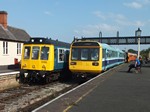 The working fleet at the railway has latterly switched to predominantly second-generation vehicles, and this convention made history by being the first example to include more second-generation sets working than first-generation. Three Pacers were in operation, with the longest serving one in preservation, 141113, supplemented by Class 142’s 142011 & 142013, the latter being launched at the event carrying passengers for the first time following restoration. All three have been returned to period 1980’s liveries which contrasts positively against the current tendency for railways to operate these sets in often increasingly careworn Northern purple. Adding to the 1980’s theme was Class 108 LO262 in Blue/Grey livery, meaning that all four sets, despite their different colours and anatomy, were all appropriate running alongside each other, recreating many scenes from the north of England in the mid to late 1980’s. We believe this is currently the only location that four 1980’s era DMU’s can be lined up alongside each other.
The working fleet at the railway has latterly switched to predominantly second-generation vehicles, and this convention made history by being the first example to include more second-generation sets working than first-generation. Three Pacers were in operation, with the longest serving one in preservation, 141113, supplemented by Class 142’s 142011 & 142013, the latter being launched at the event carrying passengers for the first time following restoration. All three have been returned to period 1980’s liveries which contrasts positively against the current tendency for railways to operate these sets in often increasingly careworn Northern purple. Adding to the 1980’s theme was Class 108 LO262 in Blue/Grey livery, meaning that all four sets, despite their different colours and anatomy, were all appropriate running alongside each other, recreating many scenes from the north of England in the mid to late 1980’s. We believe this is currently the only location that four 1980’s era DMU’s can be lined up alongside each other.
Friday
.jpg) Friday saw the traditional driver experiences with a two-train service rotating between three sets (142013 sitting out). This meant classes 108, 141 & 142 were all available to participants, who chose to partake in a single 7-mile round trip or multiple trips, with some taking advantage of adding all three to their cards!
Friday saw the traditional driver experiences with a two-train service rotating between three sets (142013 sitting out). This meant classes 108, 141 & 142 were all available to participants, who chose to partake in a single 7-mile round trip or multiple trips, with some taking advantage of adding all three to their cards!
The 108 and 142 were most popular, perhaps surprisingly as the 141 is now the only one in the world operational, so was a rarer opportunity to drive. Nevertheless, by the start of the event, all slots had sold out producing a packed schedule with half hourly departures all day.
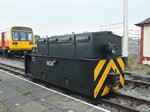 A unique surprise was making two narrow gauge locomotives available for walk-up experiences on the adjacent Golden Valley Light Railway. These included a short hop on a battery electric loco and longer runs on a diesel example. These were instructed separately by a dedicated group who were most welcoming and were also showing members around their workshop facility which was very interesting.
A unique surprise was making two narrow gauge locomotives available for walk-up experiences on the adjacent Golden Valley Light Railway. These included a short hop on a battery electric loco and longer runs on a diesel example. These were instructed separately by a dedicated group who were most welcoming and were also showing members around their workshop facility which was very interesting.
Some participants took advantage of the closed site to view the stored vehicles, particularly those at Swanwick that were starting to return to nature in a fan of sidings that had gained a significant amount of tree growth. For DMU enthusiasts it was a real treat to be able to access unrestored vehicles which for many of us prove as interesting as restored examples! Derby built Class 114, 115 & 127 vehicles were all available for viewing from paths around the larger museum site.
Saturday
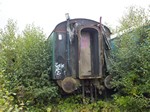 The Saturday saw the public gala event commence with the highlight being the launch of GMPTE Orange 142013, the first in preservation to receive this colour scheme. Lots of new faces, local and often younger, were seen enjoying the launch. A similar rotational system to Friday was used with all four sets running the line on a half-hourly service, with the additional operational interest of set swaps at Hammersmith, the laying-over set then running in parallel with passenger trains along the double track section across Butterley reservoir. This generated a lot of interest and interesting photo opportunities and was very different to the railway’s normal operation.
The Saturday saw the public gala event commence with the highlight being the launch of GMPTE Orange 142013, the first in preservation to receive this colour scheme. Lots of new faces, local and often younger, were seen enjoying the launch. A similar rotational system to Friday was used with all four sets running the line on a half-hourly service, with the additional operational interest of set swaps at Hammersmith, the laying-over set then running in parallel with passenger trains along the double track section across Butterley reservoir. This generated a lot of interest and interesting photo opportunities and was very different to the railway’s normal operation.
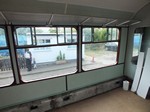 All three stations had attractions to interest visitors as well as members who had not attended on Friday. Hammersmith, normally a backwater, had the unusual set changes. Butterley was the entry/exit point for all visitors, with the Class 127 set on display in the station and the model railway in operation. The adjacent yard was also open with the magnificent Class 114 on display and an interesting Class 127 in donor mode alongside. Also present was Llangollen Railcars’ unique Class 100 set which was open for interior visits as well, with members of the restoration team on hand to explain progress so far and plans for the future of the restoration.
All three stations had attractions to interest visitors as well as members who had not attended on Friday. Hammersmith, normally a backwater, had the unusual set changes. Butterley was the entry/exit point for all visitors, with the Class 127 set on display in the station and the model railway in operation. The adjacent yard was also open with the magnificent Class 114 on display and an interesting Class 127 in donor mode alongside. Also present was Llangollen Railcars’ unique Class 100 set which was open for interior visits as well, with members of the restoration team on hand to explain progress so far and plans for the future of the restoration.
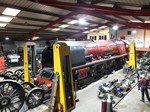 Swanwick Junction, quiet on the previous day, came alive on the Saturday with the site open for visitors (except the main museum building which is awaiting a new roof). The Golden Valley Light Railway was in operation, and many of the subgroups had their sheds open including several diesel sheds and the West Shed.
Swanwick Junction, quiet on the previous day, came alive on the Saturday with the site open for visitors (except the main museum building which is awaiting a new roof). The Golden Valley Light Railway was in operation, and many of the subgroups had their sheds open including several diesel sheds and the West Shed.
Towards the late afternoon, with parallel running over,141113 & 142011 coupled in multiple for several trips so that all four sets remained occupied on the three-train rotating system.
Formal Meeting
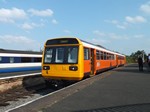 The main meeting was held in the Tin Tabernacle church on the Swanwick site, with a prompt start at 16:00. It will be a long time indeed before we forget Ian Bradbury calling members up to the church with a dog whistle! There were 28 attendees (and 2 dogs) from Aln Valley, Butterley, Cambrian, Ecclesbourne Valley, Llangollen, Mid Norfolk, North Norfolk, Swindon & Cricklade, Telford and Worth Valley railways.
The main meeting was held in the Tin Tabernacle church on the Swanwick site, with a prompt start at 16:00. It will be a long time indeed before we forget Ian Bradbury calling members up to the church with a dog whistle! There were 28 attendees (and 2 dogs) from Aln Valley, Butterley, Cambrian, Ecclesbourne Valley, Llangollen, Mid Norfolk, North Norfolk, Swindon & Cricklade, Telford and Worth Valley railways.
The meeting started with the Chairman Paul Moxon's welcome and summary. Apologies were received from Chris Bull, Gareth Coleman, Ben Darby, Kevin Dowd, Chris Nesbitt, Ben Pollard, Nigel Smith and Tim Stubbs. Paul briefly went through the current theme of continued consolidation with sales and units gradually moving homes with the odd spares donor thrown in, before handing over to the main meeting matters.
One of the most important tasks this year was considering a new president for the association following the loss of much-loved preservationist Trevor Daw of the DMU Group West Midlands. Prior to the meeting there had been discussion amongst some senor members which had led to the decision to offer the role to Nigel Tilly, who we were delighted to find accepted the offer. Nigel has given talks to us on several occasions in the past and his seniority within BR and authority on engineering matters specific to DMU’s makes him an excellent candidate for the presidency.
Nigel’s first act as president was to share a story of when he stopped the East Coast Mainline attending to a stricken unit departing Kings Cross. Following a discussion on the mechanical elements of the failure the theme of the story was that of decision making and the sometimes-conflicting priorities of BR staff all protecting their corner. The twist in the tale was that whilst subsequent traffic was diverted onto other lines, it was the Flying Scotsman itself that was trapped directly behind the humble unit, which attracted all the wrong sort of attention to what would otherwise have been a routine example of train regulation!
 Chris Deeth then gave a very informative presentation giving us the context and history of the hoisting railway and on the land on which we were sitting. The MRB was started in the 1960’s when it was decided to save some of the rapidly disappearing signalling equipment being stripped out of the local area. This was later expanded to other railway items with storage being in different areas locally and in Derby works. By 1971, a dedicated site was being searched for to create a working museum, with several locations considered before the current one was selected. It was noted that in 1973, the site had some track, but not a single building and importantly, no money! The first focus had been down the line at Butterley, where coach bodies and temporary buildings got volunteers off to a good start, with a loco shed being built, track re-laid and a light railway order granted. The ex-Whitwell station building was built on the site of the original, important to have as Butterley was the only original station site on the 3.5 mile section that we know today. Following Butterley came the main 57-acre site at Swanwick, which has remained the focus ever since. Early days saw the MSC used to reconstruct acquired buildings and steadily the site was built up, most notably with the main museum building, which is now showing its age. Contract work was tried but later scaled down, and a collaboration with private groups gives the site its current strength and sustainability. A lack of capital has been a continual theme throughout the development story. Chris finished by looking at more recent times which had involved the influx of more modern traction such as HST’s and Pacers which went together with the site being used for commercial testing contracts. This contrasted with the celebration of the vintage train of coaches and the return of several important steam locomotives. The railway is looking forwards with consolidation of staffing levels and making the most of the gained museum accreditation now that the main developments at Swanwick are largely complete.
Chris Deeth then gave a very informative presentation giving us the context and history of the hoisting railway and on the land on which we were sitting. The MRB was started in the 1960’s when it was decided to save some of the rapidly disappearing signalling equipment being stripped out of the local area. This was later expanded to other railway items with storage being in different areas locally and in Derby works. By 1971, a dedicated site was being searched for to create a working museum, with several locations considered before the current one was selected. It was noted that in 1973, the site had some track, but not a single building and importantly, no money! The first focus had been down the line at Butterley, where coach bodies and temporary buildings got volunteers off to a good start, with a loco shed being built, track re-laid and a light railway order granted. The ex-Whitwell station building was built on the site of the original, important to have as Butterley was the only original station site on the 3.5 mile section that we know today. Following Butterley came the main 57-acre site at Swanwick, which has remained the focus ever since. Early days saw the MSC used to reconstruct acquired buildings and steadily the site was built up, most notably with the main museum building, which is now showing its age. Contract work was tried but later scaled down, and a collaboration with private groups gives the site its current strength and sustainability. A lack of capital has been a continual theme throughout the development story. Chris finished by looking at more recent times which had involved the influx of more modern traction such as HST’s and Pacers which went together with the site being used for commercial testing contracts. This contrasted with the celebration of the vintage train of coaches and the return of several important steam locomotives. The railway is looking forwards with consolidation of staffing levels and making the most of the gained museum accreditation now that the main developments at Swanwick are largely complete.
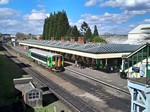 Chris Moxon's usual preservation roundup of the year followed, with just three new additions in the form of Class 153’s joining preservation. A selection of 12 vehicles had moved homes in the past 12 months with 2 more returning home from contract works. 5 restorations had been started whilst 13 vehicles had been completed following works. No major restorations had concluded during the period. It was noted that the number of vehicles operational had significantly increased, this is thought to be as a result from further Covid recovery and a realisation from railways that DMU’s provide good, cheaper, traction. There was also a large increase in the number of vehicles under restoration, though this may have been because data gathering last year missed some vehicles that were under restoration but hadn’t been reported on.
Chris Moxon's usual preservation roundup of the year followed, with just three new additions in the form of Class 153’s joining preservation. A selection of 12 vehicles had moved homes in the past 12 months with 2 more returning home from contract works. 5 restorations had been started whilst 13 vehicles had been completed following works. No major restorations had concluded during the period. It was noted that the number of vehicles operational had significantly increased, this is thought to be as a result from further Covid recovery and a realisation from railways that DMU’s provide good, cheaper, traction. There was also a large increase in the number of vehicles under restoration, though this may have been because data gathering last year missed some vehicles that were under restoration but hadn’t been reported on.
The next presentation had been partly prepared by Chris Nesbitt but was solely delivered by co-author Evan Green-Hughes as Chris was not present. Obsolescence was discussed with fluorescent tubes, halogen headlights and AFFF fire extinguishers on the way out, the latter only having had a reign of 20 years. The lighting was considered to have been covered by LED replacements though there was some discussion on how well the 30V tubes cope with spikes in charging by DMU alternators and generators. The fire extinguishers appear to be being phased out with no current viable alternative, so further observation will be required on the situation. Accidents relevant to us was a shunter being dragged by a train in Bristol, raising questions how tidy are our depots? Also relevant was the Strathspey Flying Scotsman incident shining a spotlight on cab procedures and whether staff are actually following existing rules already in place! ORR have a concern on the number of second-generation SPADs so we need to ensure assessors are correctly trained themselves. Diesel Engine Exhaust Emissions was next with the “polluting for pleasure” phrase becoming more prevalent. ORR are focusing more on this on the mainline and it is thought it will not be long before heritage is included to an extent. Options for DMU’s include reducing excessive idling, alternative fuels and improving air & vacuum leaks and injector health. Working at Height was discussed with Severn Valley Railway receiving a large fine recently, so its important to think about working practices, such as how to couple/uncouple gangways and additional risks posed when a vehicle is under restoration, such as not having a floor etc. On the subject of maintenance, there was a discussion on the updating of the successful Model Maintenance Scheme to include more overhaul guides and activities, now that this is getting more common. It was suggested a working group be formed to look into this. Also related was building in supplier information, which is partially present on the website but not fully complete. Moving onto the Heritage Railways Safety Standards Board, the HRA continues to progress it with the co-operation of the ORR but has so far (in five years) made little or no progress. We have held meetings with the HRA to explain our point of view and have made representations at HRA conferences, such as at Newcastle last November. The HRA has taken our advice in some respects and now has involved the Permanent Way Institute in its discussions. Other organisations, such as ours and the IRSE may follow. Meanwhile ‘HOPS’ has begun work on an almost identical initiative, but the two do not seem to be working together. It has proved impossible to find out who is actually working on this, or indeed who the HRA has appointed to its ‘Operating and Safety Committee’. Caution should therefore be exercised if the HRSSB is quoted to you. HRA and HOPS have both said they would be willing to adopt TRA documentation, but both wish to place it behind a paywall so that users have to pay to see it, which would be contrary to the whole principles on which the TRA was set up.
The latter part of the meeting was discussion on a few other topics. It was agreed to try and make people state their name and railway when posting on the 1st gen email group, and there had been some issues with paper engineers from across the globe hi-jacking threads and moving them well away from the practical world.
The location for the 2025 convention was discussed with the Aln Valley offering to host, however the distance of the railway away from the central belt and the lack of any first generation units may adversely affect attendance. An alternative was a joint venture centred around the existing Llangollen Railcars gala but with representation from other local lines of interest, including the Cambrian Railways at Oswestry and Llynclys. Now that we are organising one year in advance and not two years in advance, these suggestions will have to be discussed by committees etc. at the relevant railways before a confirmed choice can be made. There were no offers to host in 2026, although it had previously been noted that the Ecclesbourne Valley may be interested after the completion of thew Derby Lightweight twin, and the Severn Valley following completion of the recently arrived Class 101.
The meeting ended at 18:05 after a quick canter through Evan’s development of the Derby Lightweight slideshow which was produced from extracts from his excellent book on the subject.
Fish & Chip Special
As per tradition the Saturday evening was dedicated to a Fish & Chip special, which this year was the three second-generation units coupled in multiple, a 6-car Pacer. This brought back recent memories of the 143/144 special at the Worth Valley last year, so we have now dined on 141/142/143/144 units in recent times! There was a bar on the middle set (142011) and a social evening was had. Towards the end, the weather turned with some spectacular thunderstorms and rain normally reserved for Hollywood productions, which provided some leak testing for all the units in Derbyshire that night!
A few members moved onto the pub after the special to continue the social element, exchanging current and tales of old.
Sunday
 Sunday saw a similar timetable to Saturday, without the evening specials, for those who wanted to explore the railway further.
Sunday saw a similar timetable to Saturday, without the evening specials, for those who wanted to explore the railway further.
The Railcar Association are very grateful to the railway and the organisers for putting on such a good convention with so many interesting vehicles in service and on the site.